
| ||
|
If you enjoyed reading this, please send me an email. All correspondence is appreciated!
[Tuesday 25 September 2001 : Cape Town-Albertinia] Karen and I had to be at Cape Town station at 10 AM to board the Union Limited, a vintage steam train that did return trips to Knysna along South Africa's Garden Route. Passengers slept on board for five nights (Tuesday to Saturday), with the train arriving back in Cape Town on Sunday.
Rather than driving into Cape Town and struggling to find somewhere to leave a car in the congested city centre for six days, we strolled from my house in Kenilworth to the nearest MetroRail station and caught a suburban commuter train to Cape Town. We then walked through the concourse of Cape Town station to platform 24 and checked in at the luxurious Blue Train lounge, where we were treated to champagne, coffee and biscuits while our luggage was loaded into our compartment. A short while later when we boarded the train we were pleasantly surprized to find more champagne and a large bowl of fruit in our compartment. This was already a pretty good start and the train hadn't even left yet ...
At about midday, with a shrill blast of its whistle and a loud hissing of steam the train chugged out of the station in a cloud of billowing smoke. We traversed Cape Town's sprawling northern suburbs, past the new Century City complex, through the busy junction of Bellville and on to Dal Josafat near Paarl [Aside : Century City expanded so rapidly that a railway station was built next to it to cater for the large numbers of people who worked or lived there; this station opened just in time for the 2010 World Cup. A trip to Century City by MetroRail is described here].
There was a long wait at Dal Josafat while the steam locomotive was given a quick service, after which we continued towards Worcester without stopping at any of the suburban stations on the way. This section is on the mainline track that extends all the way north to Beit Bridge on the Zimbabwe border via Beaufort West, Kimberley, Johannesburg, Pretoria, Polokwane (formerly Pietersburg) and Musina (formerly Messina), and the ride was smooth and fast [Aside : The mainline is electrified from Cape Town to Polokwane in Limpopo province, but not between Polokwane and Beit Bridge].

Initially the railway line parallels the N1 national road, but just before Paarl the tracks veer directly north in a wide curve to avoid the formidable mass of the Du Toit's, Slanghoek and Eland's Kloof mountains (the N1 national road continues straight on over the Du Toit's Kloof pass and through the Huguenot Tunnel). This northward loop via Wellington, Tulbagh and Wolseley adds considerable distance to the rail journey, but the splendid scenery of Nuwekloof Pass, followed by the green and fertile Breede River valley, more than makes up for it. The Nuwekloof is a narrow defile cut through the mountains by the Klein Berg River, with great views from the train. It was also the route followed by the main road to Tulbagh and Ceres some years ago, before a new road (the R46) was constructed on the other side of the river - the remains of the old road can be seen from the train, between the tracks and the river.
We arrived at Worcester at about 4 PM and stopped there for about an hour. At Worcester we would have to turn off the mainline and onto the branch line that heads eastwards through the Garden Route via Robertson, Mossel Bay, George, Oudtshoorn and Knysna. We would be traversing this section of track after dark, and because of the ruling that steam locomotives may not operate on South African rail at night a diesel locomotive had to be attached to the train. While this was happening most of the passengers strolled into Worcester town centre, only a few minutes walk from the station. Worcester is surprizingly attractive and we found a pleasantly-shaded courtyard arcade where we had coffee next to a trickling fountain.
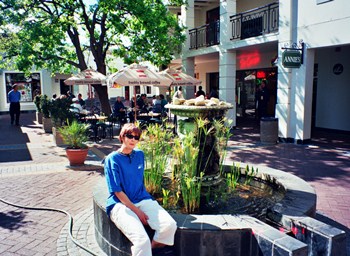
Back at Worcester station the diesel locomotives were coupled and waiting to go. With a clattering of points we pulled out of the station, the train swaying and rattling quite a lot more than before - the rails on the branch line eastward were not built or maintained to the same high standards as those of the mainline to Johannesburg. For the next couple of hours we traversed the plains of the semi-desert little Karoo until we arrived at the small town of Ashton shortly after dark. All the passengers piled into a couple of decrepit buses and were driven to the Van Loveren wine estate, about 13 kilometres out of Ashton. A magnificent farm-style dinner awaited us there - barbequed meat (called a "braai" in South Africa), potatoes, vegetables, salads, thick slabs of the most delicious bread and chunky home-made apricot jam that made me realize just how insipid most store-bought jam is. Absolutely replete, we dozed off on the bus back to the train parked in Ashton station.
But the day was not yet over. At about 11 PM we were jolted from sleep as the train pulled out of Ashton and rattled its way further east in the dark. For the next few hours we struggled to get back to sleep as the coach swayed and lurched around the curves, until eventually we reached Albertinia at about 4 AM; to our great relief this was the final stop for the night.
[Wednesday 26 September : Albertinia-Hartenbos] We woke to a grey and cloudy day but no movement of the train; looking out of our compartment window I saw that were still parked in Albertinia station. We ambled down to the dining car to see what was for breakfast, our first meal on board, and were treated to a magnificent repast of muesli, fruit, yoghurt, eggs, bacon, sausage, mushrooms, toast, muffins and several cups of the legendary (and excellent) "railway" coffee.
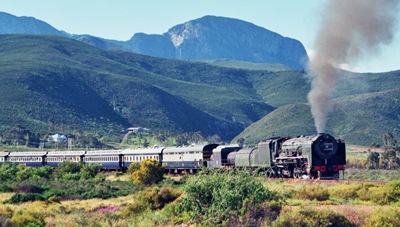
It seemed as if the train would remain in Albertinia station for some time while the diesel engines used during the night were replaced with steam locomotives, so after breakfast we climbed off to watch the shunting activity and get some fresh air. Most of the other passengers were also keenly observing what was going on and muttering knowledgeably amongst themselves. I fell into conversation with one chap and discovered that most of the people on board were train enthusiasts from England, travelling on the Union Limited as part of an organized tour to South Africa. At the end of this trip most of them would be going to Johannesburg from Cape Town on the ultra-luxury Blue Train. These "gricers" (as train enthusiasts are called) were all very pleasant people, well educated, widely-read and erudite; but their main interest was trains, and on this subject the breadth of their knowledge was staggering. We often felt like idiots when talking to them about any railway-related matter.
One of the favourite activities of these railway enthusiasts was taking photographs of the train as it thundered past, the driver having been instructed to make as much steam as possible. These "runpasts" (as they were called) were very well organized affairs, with all the photographers standing at right-angles to the tracks at the end of a long curve that typically had some interesting scenery as a backdrop. No talking or noise was allowed lest it interfered with those people taking videos. The few passengers who stayed on board the train hung out of the windows and waved like crazy as the train chugged past. We called these photographic excursions "drive-by shootings", and earned the disapproval of some of the more serious-minded gricers in the group who took a dim view of our rather flippant attitude. But the drive-by shootings were actually a lot of fun and we took some good shots of the train steaming towards us. It was also a pleasure being with people who were enthusiastic about everything they did and interested in everything they saw.
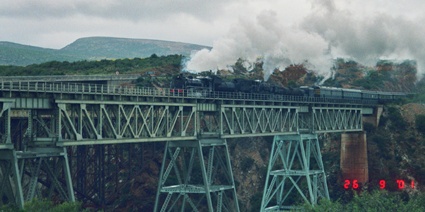
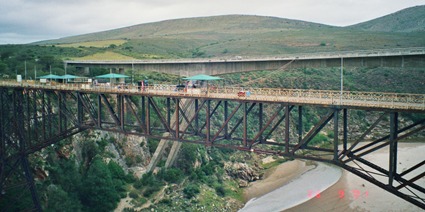
Having established that the train would only depart in a couple of hours time, we strolled down Albertinia's main street into town. There isn't much there apart from a charming old-style country hotel that looked like a very good option for a future overnight stay [Aside : In fact, we stayed at this hotel in July 2007 on our way back to Cape Town from the Eastern Cape]. But the walk did us good after the huge breakfast we'd eaten.
At around mid-morning the train finally got going again. A few kilometres east of Albertinia we crossed the Gouritz River, rattling and clanking over the deep gorge on a high metal bridge [Aside : The Gouritz River bridge is just over 62 metres above the river bed, making it the second-highest rail bridge in South Africa. Only the Van Stadens River bridge near Port Elizabeth is higher]. In fact there are three bridges over the Gouritz River gorge, all next to each other - the rail bridge, a road bridge and an old, disused bridge that was originally designed for cars but which was converted to carry rail as well. This old bridge no longer carries traffic but it is a bustling hive of activity because several commercial bungee jumping operations have taken up residence on it - we could see their umbrellas and tents as we rattled past.
Lunch was another excellent gastronomic affair of several courses which we enjoyed while on the move. During lunch the belching smokestacks and huge buildings of the Mossgas refinery slowly came into view through the windows on the right (south) side of the train, indicating that we were close to Mossel Bay. Mossel Bay is a sizeable industrial town, but the railway tracks from the west bypass it completely so we saw nothing of it except a few scattered outlying houses. Some time later the train drew to a halt in Hartenbos, a small town directly on the sea just north-east of Mossel Bay. There is a little-used railway spur from Hartenbos into Mossel Bay, but we would not be travelling on it; Hartenbos was our overnight stop.
At Hartenbos station I caught a bus into Mossel bay and visited the Diaz Museum, where there is a full-scale replica of one of the ships that Portuguese explorer Bartholomeu Diaz sailed around the Cape of Good Hope in 1488; he had dropped anchor in Mossel Bay to get fresh water. Diaz had three ships, two caravels and a large supply vessel, and his small flotilla went as far as Bushman's River mouth in what is now the Eastern Cape (several hundred kilometres further up the coast) before he turned back. The ship in the museum was built in Portugal to commemorate Diaz' voyage and was sailed to South Africa from Europe, arriving in Mossel Bay in 1988 exactly 500 years after its predecessor.
It was still early in the afternoon when I got back to the train at Hartenbos and the weather was balmy and mild, so Karen and I walked the short distance from the station down to the beach. Hartenbos is perched on a cliff above a magnificent sweep of beach that extends for miles in both directions, all the way to Mossel Bay to the south and towards Brak River to the north-east. Feeling the need for some exercise, I took off my shoes and ran along the beach for 15 minutes before turning and running back again, catching up with Karen who was walking in the other direction (towards Mossel Bay). We walked until the sun went down then trudged back again as the lights of Mossel Bay came on, twinkling across the bay. Dinner on board the train was delicious, and that night we slept soundly, soothed by the restful sound of waves crashing onto the beach nearby.
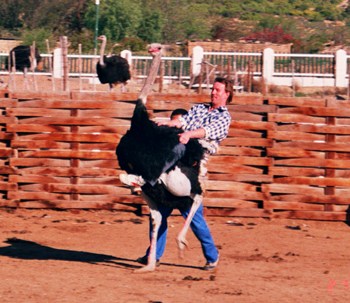
[Thursday 27 September : Hartenbos-George] Another sumptuous breakfast on board the train was followed by a day of magnificent scenery. From Hartenbos we steamed eastwards through the holiday settlement at Brak River, the tracks on a cliff-top next to the sea and affording us splendid views of the Indian Ocean (which you never get when travelling on the national road further inland). After going through a short tunnel of about 100 metres near Glentana the tracks veered inland and our views of the sea were lost. But we were entering the temperate coastal forest area of the Outeniqua Mountains, and the rolling woodlands, deep valleys and lush terrain were a more than adequate compensation. We crossed the Maalgaten and Gwaing Rivers on two high metal bridges before descending through farmland to George, regional centre of the "Garden Route".
After a brief stop in George we headed north to Oudtshoorn over Montagu Pass, one of the most scenic mountain passes in South Africa. The rail route between George and Camfer over the Outeniqua Mountains is only 34 kilometres, but features gradients as steep as 1:36 and goes through seven tunnels (ranging in length from 60 metres to 209 metres). It was the last section of railway between Port Elizabeth and Cape Town to be completed in 1913 - it took nearly three years to lay the 25 kilometres of track from George to the mountain summit at Topping. There is also a road over the Montagu Pass, built by convict labour between 1844 and 1848; the road is visible from the train as it twists and turns its way up the mountainside.
The noise of our two steam locomotives was thunderous as the train slowly chugged up the pass, thick smoke billowing past the windows. The views across the rolling hills of the Outeniqua Mountains were superb - we could see George far below us and the blue line of the Indian Ocean was faintly visible in the distance. A 180-degree turn at Horseshoe Bend signalled the start of the steepest gradient of the pass (1:36); the boom of the locomotives deepened to an angry roar as the engines struggled to haul the massive weight of the entire Union Limited consist up the slope. After quite a long, fairly straight section the line began twisting this way and that, with breathtaking views of the mountains and valleys visible first on one side of the train then the other. We finally levelled out at Topping, highest point on the route at 716 metres above sea-level, before descending somewhat more gradually down towards Camfer. From Camfer northwards to Oudtshoorn the gradient was fairly flat, the terrain characteristic of the semi-desert Little Karoo region. When we finally drew to a halt in Oudtshoorn station I could almost imagine the locomotives heaving a sigh of relief at the thought of being given a rest after their exertions up the pass.
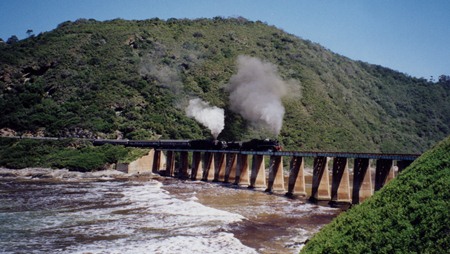
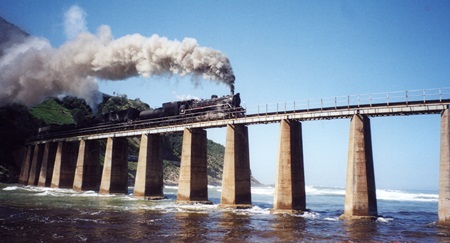
Buses were waiting at the station to ferry us to Oudtshoorn Ostrich Farm, just outside town. We looked at ostriches, heard about how these huge birds are kept and bred and then the guide challenged somebody to ride one. All of the train passengers declined except Karen and me ... what were we thinking? However, once we'd volunteered there was no getting out of it, so I gingerly climbed aboard my designated ostrich while a handler kept the poor bird from bolting. "Lock your ankles underneath and hold onto the wings, not the neck" I was told, and then the ostrich was off, careering around the enclosure with me clinging on desperately. In truth it wasn't very difficult and was actually a lot of fun. Karen enjoyed it so much she couldn't keep the grin off her face.
We also looked at some other non-avian wildlife at the Cango Game Ranch (crocodiles, cheetahs and some truly gigantic tortoises) before heading back to the train. The return journey over Montagu Pass down to George was just as spectacular as before, although a lot less noisy because the locomotives hardly worked at all - most of the time it was simply a case of standing on the brakes to prevent the train from rolling downhill out of control. We parked overnight in George station, the main attraction of which is the Signalman's Arms, a pub on the main platform that has achieved legendary status amongst the train-spotting fraternity. This famed watering hole received a non-stop stream of visitors from our train during the course of the evening, many of whom weaved a rather unsteady path back to their compartments afterwards.
[Friday 28 September : George-Knysna] From George the Cape Town-Port Elizabeth railway heads north to Oudtshoorn and then east through the arid plains of the Eastern Cape interior (Karen and I did the trip to Port Elizabeth in January 2009). But there is also a branch line eastwards from George that threads its way along the coast, between several lakes and across Knysna Lagoon to the coastal town of Knysna, and this was the way we would be travelling today. Opened in 1928, the 67 kilometre George-Knysna railway line is regarded as the most spectacularly beautiful section of railway in South Africa. And indeed it was magnificent, as we slowly chugged between the various lakes around Sedgefield, through thick forest and over raging rivers.
Almost immediately after leaving George the train skirted the tiny holiday settlement (and surfing mecca) of Victoria Bay. The tracks clung precariously to the cliffs above the town and went through two short tunnels before reaching the Kaaimans River, the highlight of the entire trip - the bridge over the Kaaimans River is reputed to be the most photographed railway bridge in the world. We steamed over the bridge, thirty metres above the foaming waters of the river and immediately entered another tunnel (this one was about 75 metres in length). The train emerged from the tunnel and arrived in Wilderness, another popular holiday town. We stopped briefly at the quaint little station at Wilderness before clattering over the bridge spanning the Touw River, the massive rollers of the Indian Ocean crashing onto the beach only a stone's throw from our carriage windows.

Beyond Wilderness we found ourselves in lake country. For the next several kilometres we had thick forests and water on both sides of the train, with the various lakes being crossed via causeways or low bridges that were no more than a metre or two above the water (it is interesting to note that all of these lakes are saline except for Groenvlei, which is the only fresh-water lake on the Garden Route). Most of the time the railway tracks were north of the N2 national road, but near Goukamma the train crossed over the road and the Goukamma River and swung south then east again to the summit of a minor hill at Keytersnek. Shrubby fynbos now replaced the forests and plantations we'd seen earlier. A few minutes later Knysna Lagoon came into a view, a huge expanse of sparkling blue water sprinkled with small boats, waterskiers and boardsailors. On the far side of the lagoon we could just make out the tiny matchbox-size shapes of cars on the road that skirts the lagoon.
The train descended to the little settlement of Brenton-on-Lake and then started the crossing of the lagoon, a rail distance of two and half kilometres. The tracks over the lagoon are laid on a combination of causeways and bridges; a causeway could not be built all the way across because the lagoon is tidal and water has to be able to flow freely. The lagoon is so wide and the bridges so low that the sensation was one of riding on water, and with a necessarily-reduced speed we enjoyed several minutes of this incredible experience before reaching dry land on the other side. Knysna station is situated a few metres from the lagoon, adjacent to the swanky new waterfront development. This would be our overnight spot but it was not midday yet so we had the rest of the day to explore Knysna.
Late in the afternoon we met the other passengers on the waterfront and boarded the John Benn, a leisure boat that ferries tourists around Knysna lagoon. We cruised round the lagoon for an hour, savouring a magnificent sunset and a glass of wine and watching with trepidation as we inched closer to the dangerous swells raging through the Heads. Many boats have foundered in these treacherous waters over the years, but thankfully we suffered no mishap and docked safely back at the waterfront just before dark.

[Saturday 29 September : Knysna-Worcester] We enjoyed a relaxing morning in Knysna, browsing around the shops in the waterfront and on the main road, a couple of blocks up from the station. Despite a determined effort by the town fathers to ruin the pleasant ambience of the town with a series of crass and tasteless commercial developments, Knysna still retains an element of rustic charm - the new waterfront centre has re-vitalised the area around the train station and the large number of log buildings that can be seen reflect the town's historical dependence on the thick forests surrounding it. Knysna is also small enough that the whole town can easily be covered on foot.
At midday we returned to the train for a hearty lunch in the dining car, and while we were ordering our food the locomotives slowly hauled us out of the station. We retraced our route of the previous day, across the lagoon and through Goukamma, Sedgefield, Fairy Knowe, Wilderness and the spectacular Kaaimans River before reaching George. Then it was the long haul back to Cape Town and we spent the whole day on the move, apart from a stop in Hartenbos where the steam locomotives were replaced with diesels and the passengers enjoyed a brief stroll on the beach. The train arrived in Worcester, our overnight stop, well after dark.
[Sunday 30 September 2001 : Worcester-Cape Town] This morning we enjoyed our last breakfast on board the train as we rolled through the Western Cape wheat fields, once again enjoying the views in the Nuwekloof. At Dal Josafat (near Paarl) the steam locomotives were uncoupled for the last time and we did the remaining few kilometres to Cape Town with electric traction. Early afternoon saw us draw to a stop alongside platform 24 at Cape Town station; with much regret we bade farewell to our luxurious moving home of the previous six days and trudged through the crowded concourse to the suburban platforms for the commuter train back home again.